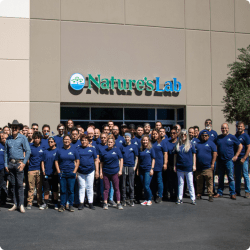

Are you just starting a new workout routine or already a seasoned gym veteran? Whether a newbie or a regular, it’s important to take care of your joints so you can stay active. What are some supplement ingredients that can help you meet your fitness goals and minimize wear and tear on the joints?* We take a closer look at common nutrients found in joint supplements: hyaluronic acid, hydrolyzed collagen type II and chondroitin sulfate.
Hyaluronic Acid Nourishes the Joints

If you’ve ever seen an illustration of a knee joint, it is a fascinating structure. Much like a well oiled machine, the bones, ligaments and tendons present in our knees or other joints work together to promote smooth functioning. One of the most important components of the knee is its cartilage. Cartilage helps cushion the knee against force and physical stress. Cartilage cells called chondrocytes produce collagen and hyaluronic acid which contributes to its firm, gel-like structure. Within the knee, the articular cartilage is surrounded by synovial fluid, which contains a high percentage of hyaluronic acid. This thick viscous fluid has a consistency similar to egg whites which promotes smooth movement of the joints.
An advantage to taking supplements that contain hyaluronic acid is its two-fold effect on hyaluronic acid levels in your body. It not only provides additional hyaluronic acid for your body to use, but suppresses the enzyme that breaks down hyaluronic acid.* Another benefit of hyaluronic acid supplements is that they can reduce levels of inflammatory metabolites that are sometimes produced as a byproduct of cartilage cell activity.* Reducing inflammation is important for maintaining the health of your joints.
Collagen - Your Joints’ Foundation

Many became familiar with collagen when it was a popular ingredient used to plump lips in the 1980s and 1990s. But collagen is so much more than a cosmetic enhancement. Collagen is a type of protein that is made in our body. Nearly one-third of all protein found in the body is in the form of collagen protein. It is one of the main building block components of soft tissue, including ligaments, tendons and cartilage. You’ll also find collagen protein within the lining of the digestive tract, skin layers, hair strands, blood vessels, and nails among others.
We start losing existing collagen and creating less collagen in our 20’s and this escalates as we get older. Lifestyle factors such as smoking, taking in too much sugar or exposure to UV rays can make you lose collagen even faster. Taking in additional collagen helps replenish lost collagen stores and provides the raw building materials your body requires for healthy joints.
Anti-inflammatory Chondroitin Sulfate and MSM

Chondroitin sulfate and MSM (methylsulfonylmethane) supplements are used to promote enhanced mobility in individuals with stiff joints.* Inflammatory chemicals such as nitric oxide synthase and COX-2 (cyclooxygenase-2) are notorious for wreaking havoc on the joints and causing damage. Both chondroitin sulfate and MSM have antioxidant abilities that neutralize the substances. Another manner in which these nutrients support the joints is that they both contain sulfur molecules. Sulfur content decreases as joints age and become stiff. Sulfur is also required to produce collagen, which also supports the strength of joints.
Turmeric for Joint Mobility

Turmeric nourishes the joints by providing another anti-inflammatory agent to fend off damaging molecules. Inflammation can break down cartilage, leading to a host of health issues. Turmeric curcuminoids can calm inflammation and studies show a connection between turmeric consumption and increased knee mobility.* Upping your intake of nutrients like curcumin can be useful in reducing oxidative stress that damages joints.*
Finding the Right Joint Supplement

One of the issues with collagen supplements is that not all are created equal. Collagen is a large molecule that makes it great for creating resilient structures in the body. However, the size can be difficult for the digestive system to absorb. A proper collagen supplement will need to contain collagen that is broken down into smaller fragments such as peptides or amino acids. Hydrolyzed collagen is an example of this type of broken down collagen. Nature’s Lab Gold Turmeric + Joint Complex combines the top nutrients for joint health- hyaluronic acid, hydrolyzed collagen, chondroitin sulfate, turmeric (standardized to 95% curcuminoids) and MSM (methylsulfonylmethane) into one bottle. This supplement also includes Bioperine® black pepper extract to further increase the absorption of turmeric and other ingredients.*
Shop our collection of joint health supplements today!
References
Research supports effectiveness of BIOCELL Collagen® in promoting skin health, preventing wrinkles. Biocell Technology. (2012, March 19). Retrieved December 28, 2022, from https://www.biocelltechnology.com/blog/research-supports-effectiveness-biocell-collagen-ii%C2%AE-promoting-skin-health-preventing-wrinkles
Henrotin, Y., Mathy, M., Sanchez, C., Lambert, C. (2010, December). Chondroitin sulfate in the treatment of osteoarthritis: From in vitro studies to clinical recommendations. Therapeutic advances in musculoskeletal disease. Retrieved December 28, 2022, from https://www.ncbi.nlm.nih.gov/pmc/articles/PMC3383492/
Calderón-Pérez, L., Llauradó, E., Companys, J., Pla-Pagà, L., Boqué, N., Puiggrós, F., Valls, R.-M., Pedret, A., Llabrés, J. M., Arola, L., Solà, R. (2021, April). Acute effects of turmeric extracts on knee joint pain: A pilot, randomized controlled trial. Journal of medicinal food. Retrieved December 28, 2022, from https://www.ncbi.nlm.nih.gov/pmc/articles/PMC8080919/
Centers for Disease Control and Prevention. (2021, November 15). Pain during or after exercise. Centers for Disease Control and Prevention. Retrieved December 28, 2022, from https://www.cdc.gov/arthritis/basics/physical-activity/pain.html
Kannus, P (n.d.). Structure of the tendon connective tissue. Scandinavian journal of medicine science in sports. Retrieved December 28, 2022, from https://pubmed.ncbi.nlm.nih.gov/11085557/
Collagen: What it is, types, function benefits. Cleveland Clinic. (n.d.). Retrieved December 28, 2022, from https://my.clevelandclinic.org/health/articles/23089-collagen
Vincent, H. K., Percival, S. S., Conrad, B. P., Seay, A. N., Montero, C., Vincent, K. R. (2013, September 20). Hyaluronic acid (HA) viscosupplementation on synovial fluid inflammation in knee osteoarthritis: A pilot study. The open orthopaedics journal. Retrieved December 28, 2022, from https://www.ncbi.nlm.nih.gov/pmc/articles/PMC3788189/
Migliore, A., Procopio, S. (2015, June 1). Effectiveness and utility of hyaluronic acid in osteoarthritis. Clinical cases in mineral and bone metabolism : the official journal of the Italian Society of Osteoporosis, Mineral Metabolism, and Skeletal Diseases. Retrieved December 28, 2022, from https://www.ncbi.nlm.nih.gov/pmc/articles/PMC4469223/







